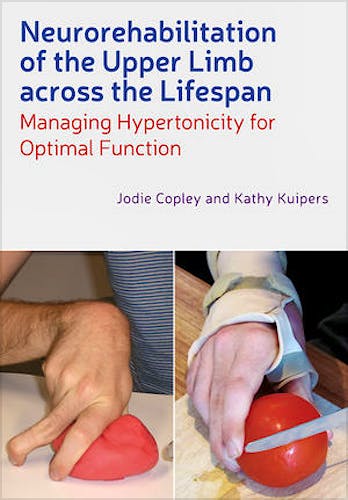

No hay productos en el carrito



Neurorehabilitation of the Upper Limb across the Lifespan. Managing Hypertonicity for Optimal Function
Copley, J. — Kuipers, K.
1ª Edición Junio 2014
Inglés
Tapa blanda
392 pags
594 gr
17 x 25 x 2 cm
ISBN 9780470670316
Editorial WILEY
LIBRO IMPRESO
-5%
52,80 €50,16 €IVA incluido
50,77 €48,23 €IVA no incluido
Recíbelo en un plazo de
2 - 3 semanas
LIBRO ELECTRÓNICO
-5%
40,55 €38,52 €IVA incluido
38,99 €37,04 €IVA no incluido
Acceso On Line
Inmediato
Description
- A comprehensive guide to managing spastic hypertonia after brain injury and the first full overview of this area
- The ideal reference for therapeutic interventions that optimise arm and hand function to support goal achievement
- An extensive clinical manual for neurological practice, a key reference for students and qualified practitioners, and a valuable resource for all occupational therapists and physiotherapists working with brain-injured clients
Table of Contents
Acknowledgements
1. Seeing the Bigger Picture: Using Clients’ Experiences to Shape Clinical Practice, 1
- 1.1. Appreciating the client’s experiences, 1
- 1.2. Providing or assisting access to long-term services, 1
- 1.3. Initiating and supporting transitions from one service to the next, 3
- 1.4. Listening carefully and providing relevant information, 4
- 1.5. Collaborating on achievable goals, 5
- 1.6. Actively supporting and involving caregivers, 6
- 1.7. This book: Promoting collaborative, client-centred intervention, 7
- References, 7
2. What Happens to the Upper Limb After Brain Injury?, 9
- 2.1. Motor control and normal movement, 9
- 2.2. Upper limb movement, 17
- 2.3. Brain injury and movement dysfunction, 19
- 2.4. Upper motor neuron syndrome, 20
- 2.5. The clinical picture: Interaction of positive and negative features, 37
- 2.6. Summary, 45
- References, 45
3. The Hypertonicity Intervention Planning Model for Upper Limb Neurorehabilitation, 54
- 3.1. Decision-making in clinical practice, 54
- 3.2. Evidence-based practice:What it is and what it isn’t, 56
- 3.3. Clinical reasoning: A process of integration and differentiation, 61
- 3.4. The hypertonicity intervention planning model for upper limb neurorehabilitation, 65
- 3.5. Summary, 73
- References, 73
4. Making Sense of the Clinical Picture, 80
- 4.1. The ICF as an assessment framework, 80
- 4.2. Gathering information, 81
- 4.3. Upper limb assessment, 87
- 4.4. Goal formulation, 107
- 4.5. Summary, 110
- References, 111
4.A. Information Gathering Using a Concept Map Structure, 116
4.B. Upper Limb Performance Analysis (ULPA) Part 2: Comparative Analysis of
Performance – Motor (CAP-M), 117
4.C. Upper Limb Hypertonicity Assessment Form, 119
5. Case Studies, 128
- 5.1. Wendy, 128
- 5.2. Harry, 134
- 5.3. Tony, 138
- 5.4. Summary, 144
6. Movement and Strength Training, 145
- 6.1. Changes in rehabilitation theory and practice, 145
- 6.2. Common rehabilitation approaches: Assumptions, principles and strategies, 146
- 6.3. A selection of contemporary techniques: Indications and considerations, 149
- 6.4. Summary, 176
- References, 177
7. Splinting, 186
- 7.1. Splinting: Proposed mechanisms of effect, 186
- 7.2. Splinting research: A narrative review, 190
- 7.3. Hypertonicity intervention planning model (HIPM): Indications for splinting, 202
- 7.4. Splint prescription, 202
- 7.5. Common splint designs, 213
- 7.6. Adapting splint designs, 214
- 7.7. Commercially-produced Splints, 214
- 7.8. Wearing schedules, 216
- 7.9. Fabrication principles, 218
- 7.10. Summary, 223
- References, 223
7.A. Common Splint Designs, Patterns and Fabrication Instructions, 230
7.B. Splint Care and Precautions, 274
7.C. Example of a Photographic Splint Programme, 275
8. Casting, 278
- 8.1. Casting classification, 278
- 8.2. Casting research: A narrative review, 282
- 8.3. Indications for casting, 284
- 8.4. Contraindications for casting, 284
- 8.5. Casting considerations, 290
- 8.6. Casting process, 294
- 8.7. Post-casting follow-up programme, 298
- 8.8. Summary, 301
- References, 301
8.A. Casting Procedures, 304
8.B. Casting for Arms and Hands: Information Sheet, 316
8.C. Casting Agreement, 317
8.D. Casting Documentation Form Page 1, 318
8.D. Casting Documentation Form Page 1, 319
8.E. Precautions and Cast Care During Casting Series, 320
9. Botulinum Neurotoxin, 321
- 9.1. Clostridium botulinum, 321
- 9.2. Mechanism of effect, 323
- 9.3. Botulinum neurotoxin research: A narrative review, 326
- 9.4. Guidelines for practice, 329
- 9.5. Summary, 335
- References, 335
10. Surgery, 339
- 10.1. Classification of surgical procedures, 339
- 10.2. Surgery: A narrative review, 340
- 10.3. Indications for surgical intervention, 347
- 10.4. Surgical consultation: Information sharing, 350
- 10.5. Post-surgery follow-up, 351
- 10.6. Summary, 352
- References, 352
11. Case Studies Revisited, 355
- 11.1. Wendy – intervention process and outcomes, 355
- 11.2. Harry – intervention process and outcomes, 360
- 11.3. Tony – intervention process and outcomes, 362
- 11.4. Summary, 366
Index, 369
Author Information
Jodie Copley is Senior Lecturer, Clinical Education Program Coordinator and Clinic Manager of the UQ Upper Limb Hypertonicity Clinic at the School of Health and Rehabilitation Sciences, University of Queensland, Australia.
Kathy Kuipers is Co-Director of OptimiseRehab, a private occupational therapy practice providing rehabilitation services to children and adults with upper limb hypertonicity, and Lecturer in the Division of Occupational Therapy, School of Health and Rehabilitation Sciences, University of Queensland, Australia.
© 2025 Axón Librería S.L.
2.149.0